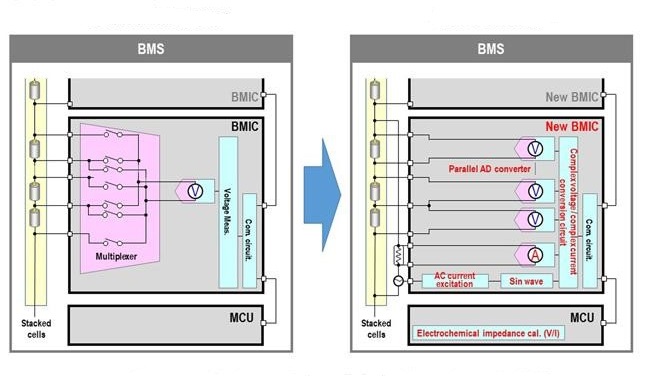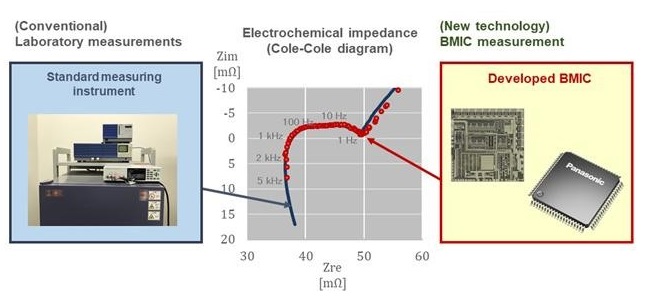A sustainable future for lithium-ion batteries
Panasonic Semiconductor Solutions collaborated with Ritsumeikan University to develop technology that evaluates the residual value of lithium-ion batteries for reuse and recycling
A sustainable future for lithium-ion batteries
Panasonic has developed a battery management technology to measure electrochemical impedance of multi-cell stacked lithium-ion batteries, as an effective method to evaluate the residual value of lithium-ion batteries.
This technology is expected to be applied to devices that use lithium-ion battery modules, with many battery cells stacked in series and to electric vehicles where the responsible disposal of battery packs is already causing concern.
Through the collaboration, Panasonic developed a new battery monitoring IC (BMIC) test chip, measurement algorithm and software. The chip can measure the electrochemical impedance of a battery in operation without significantly changing the configuration of the battery’s current battery management system (BMS). Furthermore, it achieves electrochemical impedance measurement with the same accuracy as a standard measuring instrument, says the company.
Recycling
Current applications of lithium-ion batteries are expanding to the field of industrial devices and mobility and the importance of reuse and recycling is also increasing. This battery management technology makes it possible to measure electrochemical impedance using the AC current excitation method for lithium-ion stacked battery modules that are installed in operating devices.
(AC current excitation, also called AC superposition, is similar to network analysis, a method of measuring the frequency characteristics of AC impedance by applying AC current while sweeping the frequency.)
It also aims to enable the evaluation of residual value by way of a deterioration diagnosis and failure estimation based on an analysis of acquired measurement data. This will contribute to the realisation of a sustainable society where future lithium-ion batteries can be reused and recycled.
The technology also includes temperature calibration that responds to changes in the temperature of operating devices.
Conventional electrochemical impedance spectroscopy is widely used as a non-destructive method for evaluating lithium-ion batteries. This measurement method requires an application specific measuring instrument and a large thermostatic chamber that keeps the temperature of the battery constant. In addition, it is necessary to measure each cell in the laboratory.
Electrochemical impedance
Conventional BMIC measures the individual battery voltage of six to 14 lithium-ion battery cells stacked in series. By using multiple BMICs, the BMS acquires battery cell voltage data from up to 200 cells connected in series, monitors the battery, and ensures its safe use. In addition, BMS calculates the remaining driving range and usable time by estimating the state of charge, as a percentage of the remaining capacity with respect to the full charge capacity, and the state of health (SOH).
SOH is the ratio between the initial charge and the amount of charge that has deteriorated over time. The amount of charge is measured by the current integration method (Coulomb counting), by the BMS. The current SOH can be calculated by storing the charge amount at the start of use and comparing it with the current charge amount. However, SOH has no direct correlation with various lithium-ion battery deterioration phenomena such as electrode deterioration due to metal lithium deposition (dendrites) and electrolyte deterioration. Therefore, the SOH measurement is for obtaining the current charge amount, it cannot estimate the future SOH, and is different from the deterioration diagnosis.
 Figure 1: Schematic diagram of BMS and BMIC in conventional (left) and the new technology (right)
Figure 1: Schematic diagram of BMS and BMIC in conventional (left) and the new technology (right)
The BMIC test chip has a built-in electrochemical impedance measurement function using the AC current excitation method in addition to these conventional functions. The electrochemical impedance measurement is achieved by 15 parallel ADCs and an AC current excitation circuit with pulse modulation from 0.1Hz to 5kHz and a complex voltage/complex current conversion circuit built in the BMIC. Therefore, the BMIC chip can measure the electrochemical impedance of a battery in operation without significantly changing the configuration of the current BMS installed in the battery. The new technology can be installed simply by replacing the BMIC (see Figure 1).
Measurement method
The partners report that this technology achieves the electrochemical impedance measurement with the same accuracy as a standard measuring instrument.
State estimation by electrochemical impedance spectroscopy is performed by measuring the Cole-Cole diagram drawn with complex impedance.
The Cole-Cole diagram, invented by Kenneth S Cole and Robert H Cole, is also called a Nyquist diagram. It is a complex representation of the AC impedance, and the frequency sweep trace is plotted on the complex plane. It is often used in electrochemical impedance spectroscopy to analyse changes in the internal AC impedance of battery cells.
Ritsumeikan University measured cylindrical lithium-ion battery cells using BMIC and measurement software developed by Panasonic. As a result, it was confirmed that the Cole-Cole diagram can be measured in the frequency range from 1Hz to 5kHz with the same accuracy as the standard measuring instrument used in the industry. Figure 2 compares the measurement methods.
Temperature considerations
It was also recorded that the temperature calibration technology responds to changes in the temperature of operating devices.
 Figure 2: Comparison of Cole-Cole diagram measurement with dedicated measuring instrument and new BMIC
Figure 2: Comparison of Cole-Cole diagram measurement with dedicated measuring instrument and new BMIC
The electrochemical impedance of lithium-ion batteries is very sensitive to temperature changes. For this reason, measurements using dedicated measuring instruments in the laboratory are performed by placing the battery in a thermostatic chamber that maintains a constant temperature. The battery module in operation could not achieve a stable measurement of electrochemical impedance because the environmental temperature changed. To address this, Ritsumeikan University and Panasonic developed a temperature correction technology that measures the temperature of the lithium-ion battery during the electrochemical impedance measurement, corrects the temperature change of the impedance to the standard temperature and draws it on the Cole-Cole diagram.
This makes it possible to accumulate Cole-Cole diagrams normalised to the standard temperature in the database even when the environmental temperature varies depending on the season and time.
Electrochemical impedance spectroscopy is widely used as a non-destructive method of evaluating lithium-ion batteries. This measurement method requires an application specific measuring instrument and a large thermostatic chamber that keeps the temperature of the battery constant, and it was necessary to measure each cell in the laboratory.
Suitable applications
This technology is expected to be applied to various devices that use lithium-ion battery modules with many battery cells stacked in series and to future vehicles, contributing to a sustainable society by helping facilitate reuse and recycling of lithium-ion batteries.
Devices which typically use multi-cell stacked lithium-ion batteries are electric bikes (e-bikes), low speed vehicles (LSVs), construction and logistics machinery. In the future, they are expected to be used in electric vehicles (EVs) which use large-capacity storage batteries.
Panasonic’s BMIC test chip can measure the electrochemical impedance of a battery in operation without significantly changing the configuration of the current BMS installed in the battery. Furthermore, it achieves electrochemical impedance measurement with the same accuracy as a standard measuring instrument.











